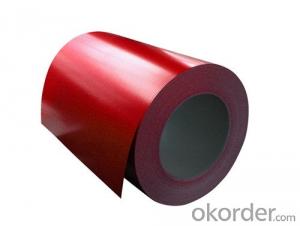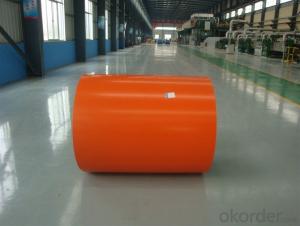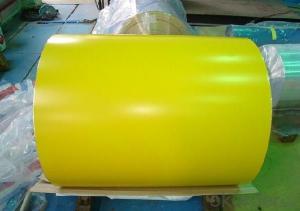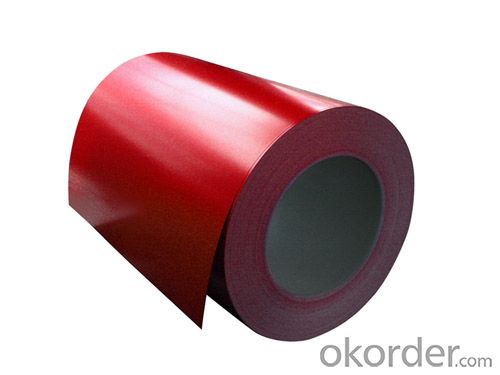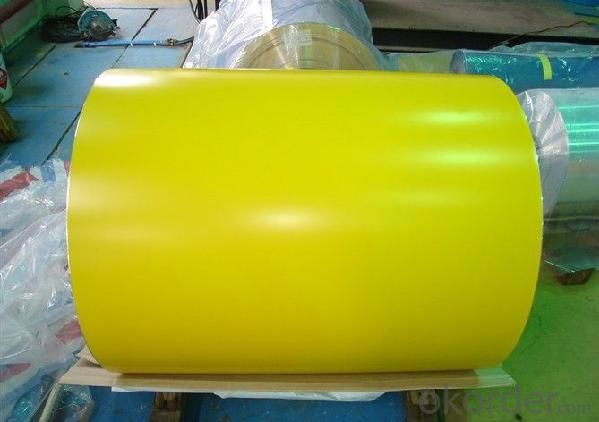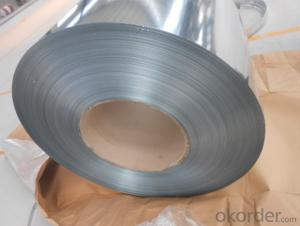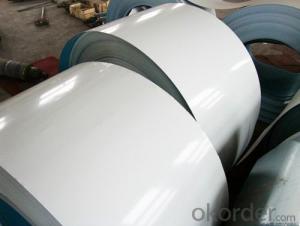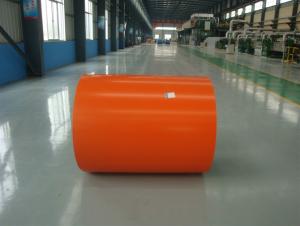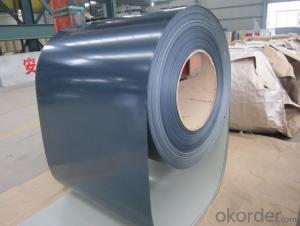HJ PRE-PAINTED ALUZINC STEEL COIL
- Loading Port:
- Tianjin
- Payment Terms:
- TT OR LC
- Min Order Qty:
- -
- Supply Capability:
- 8000 m.t./month
OKorder Service Pledge
Quality Product, Order Online Tracking, Timely Delivery
OKorder Financial Service
Credit Rating, Credit Services, Credit Purchasing
You Might Also Like
PRE-PAINTED ALUZINC STEEL COIL
THICKNESS:0.18mm-1.5mm
WIDTH:900mm-1250mm
COATING MASS:AZ30-AZ180
PAINT:PE、HP、HDP、PVDF、SMP、MATT、PVDF
COLOR:RAL Scale
COIL INNER DIAMETER:508mm/610mm
COIL WEIGHT:3mt-7mt
BASE MATERIAL:Hot-dip Aluzinc Steel
- Q: How do steel coils contribute to sustainability efforts?
- Steel coils contribute to sustainability efforts in several ways. Firstly, steel is a highly recyclable material, and steel coils can be recycled and reused multiple times without losing their quality or strength. This reduces the demand for virgin steel production, which is an energy-intensive and environmentally damaging process. By incorporating recycled steel coils into manufacturing processes, companies can significantly reduce their carbon footprint and conserve natural resources. Additionally, steel coils have a long lifespan and are highly durable. This means that products made using steel coils, such as automotive parts, construction materials, or appliances, tend to have a longer lifespan as well. The longevity of these products reduces the need for frequent replacements, reducing waste generation and conserving resources. Furthermore, steel coils can be manufactured using advanced technologies that improve energy efficiency and reduce greenhouse gas emissions. Steel manufacturers are increasingly adopting more sustainable practices, such as using energy-efficient furnaces, optimizing production processes, and implementing recycling initiatives. These measures help minimize the environmental impact of steel production and contribute to overall sustainability efforts. Moreover, steel coils are often used in the construction industry, which plays a crucial role in sustainable development. Steel is a key component in the construction of energy-efficient buildings and infrastructure, such as green buildings and renewable energy projects. These structures are designed to minimize energy consumption, reduce emissions, and promote resource efficiency. By using steel coils in these sustainable construction projects, the industry can contribute to a greener and more sustainable future. In summary, steel coils contribute to sustainability efforts through their recyclability, durability, energy-efficient manufacturing processes, and their role in sustainable construction. By choosing steel coils and promoting their use, companies and industries can reduce their environmental impact, conserve resources, and help build a more sustainable society.
- Q: I've created something but it's a huge secret. Anyways I need to know everything and anything about steel. Like the iron steel. ANYTHING AND EVERYTHING. Best answer goes to the person with the most correct information. Please this is really important.
- If you want to know everything about steel, there's no way you're going to get an answer on Yahoo that is comprehensive enough. What you want to do is get some books on steel metallurgy, engineering properties of materials, and maybe machine design depending on your application. Topics will include molecular structure, material properties, alloying, stress and strain, work hardening, creep, computing damage and lifetime cycles, corrosion, toughness vs hardness, heat treating, and a ton of others. If you want to sharpen steel, that is a whole topic in itself concerning different blade profiles and their sharpness, edge holding, ease of sharpening, type of grind etc.
- Q: What are the typical lead times for ordering steel coils?
- The typical lead times for ordering steel coils can vary depending on various factors such as the type and size of the coil, the supplier's production capacity, and the current market conditions. However, on average, lead times for ordering steel coils can range from a few weeks to several months. For standard-sized steel coils that are readily available in the market, lead times are generally shorter and can range from a few weeks to a couple of months. This is because suppliers often maintain a stock of these commonly used coil sizes to meet immediate customer demands. However, it's important to note that lead times can still be influenced by factors like transportation and logistics. On the other hand, if you require custom-made or non-standard steel coils, lead times can be longer. These coils usually involve additional processes such as specialized cutting, shaping, or coating, which may require more time for production. Lead times for custom-made steel coils can range from a few months to even six months or more, depending on the complexity of the specifications and the supplier's production capabilities. It's worth mentioning that lead times can also be affected by external factors like market demand and availability of raw materials. During periods of high demand or when there are supply chain disruptions, lead times may be extended as suppliers need to adjust their production schedules accordingly. To accurately determine the lead times for ordering steel coils, it is recommended to reach out to specific suppliers or manufacturers. They will be able to provide you with the most up-to-date and accurate information based on your specific requirements and the current market conditions.
- Q: i got the belly button ring from icing and its surgical steel are they the same things?
- There are several different grades and specifications that are referred to collectively as surgical steel, or Surgical stainless steel Non-stainless steel is not used for piercings and sutures and the like, because of the obvious reason that it tends to rust. The most common grade referred to as surgical is 316L, which is also used for food handling equipment. 316L is tough and very durable and has outstanding corrosion resistance. But it is moderately expensive. Very cheap body jewelry may be made out of cheaper grades of stainless steel like 304 or even the dirt-cheap 409. 304 is less corrosion resistant than 316L ; Almost nothing good can be said of type 409, except that's it cheap. 409 is not technically known as surgical, but some manufacturers may claim it is, to increase their asking price and also to cause buyer confusion. Surgical tools, which are not meant to be implanted, are usually made of the well known 440C, which is extremely strong and excellent at holding and edge, but it is not very corrosion resistant and it is brittle. 440C is not usually considered surgical. It's also used to make kitchen knives.
- Q: How are steel coils used in the production of pipelines?
- Steel coils are used in the production of pipelines as they are rolled into flat sheets and then formed into the required shape. These coils provide the necessary strength and durability for the pipelines, ensuring they can withstand the high pressure and harsh conditions they will be exposed to.
- Q: i have a computer chair where the metal part that attachs the top part to the bottom with wheels has cracked around half of the assembly. my dad said it might be able to be repaired with jb weld. can jb weld fix it? how strong is jb weld? is it as strong as steel?
- the stuff is pretty strong... i have a friend who blew a hole in his crankcase of his 07 cr450f and used jb weld on it... added oil and rode on it.. the stuff is crazy strong just give it a day to dry
- Q: But we've had a problem with bears being attracted to the water in the Intex Inflatable pools, the bear would come at night every so often and push on the sides letting out the water.Would a bear be able to bend a steel frame before I go and spend money?
- depends on the steel thickness and positioning. frm your question I'm guessing you're not really well versed in steel framing or use... im guessing whatever you build, a bear can destroy. if i was to build it not even 100 bears can destroy it. it doesn't require much steel, it's just about bracing the positing of steel and some design.
- Q: What are the common coil diameter and weight combinations available for steel coils?
- The available combinations of coil diameter and weight for steel coils vary depending on specific requirements and industry standards. However, the market offers commonly used combinations that are widely accessible. Coil diameter commonly ranges from 24 inches (610 mm) to 72 inches (1829 mm). These sizes are often utilized in industries such as automotive, construction, and manufacturing. Coil weight varies significantly based on the steel type and thickness. In the case of hot-rolled coils, the weight typically falls between 5 to 30 metric tons. For cold-rolled coils, the weight usually ranges from 2 to 20 metric tons. Heavier coils are commonly applied in heavy-duty situations, while lighter coils are preferred for delicate or precise applications. It's important to remember that these are general guidelines, and the actual combinations of coil diameter and weight can be customized to meet a customer's specific needs. Different manufacturers and suppliers offer a wide range of options to accommodate various industry requirements. Therefore, it is advisable to consult with the specific supplier to determine the available coil diameter and weight combinations that best suit your application.
- Q: What are the different types of steel coil edges?
- The different types of steel coil edges include mill edge, sheared edge, slit edge, and deburred edge.
- Q: I'm analysing horse stirrups and would like to know the disadvantages to stainless steel? - thanks
- For horse stirrups the main disadvantage to stainless steel is the manufacturing cost. Stainless steels tend to work harden, and are subject to their own peculiar forms of corrosion, but I see little implication to either of these factors when used as a stirrup iron or a safety latch. Stainless steel is also subject to self welding, or galling, this would be of no concern for the irons, but could result in the pivot of the safety latch freezing (I have never known anyone to ride with the safety latch closed, however).
Send your message to us
HJ PRE-PAINTED ALUZINC STEEL COIL
- Loading Port:
- Tianjin
- Payment Terms:
- TT OR LC
- Min Order Qty:
- -
- Supply Capability:
- 8000 m.t./month
OKorder Service Pledge
Quality Product, Order Online Tracking, Timely Delivery
OKorder Financial Service
Credit Rating, Credit Services, Credit Purchasing
Similar products
Hot products
Hot Searches
Related keywords
